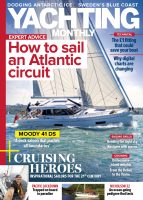Each month Yachting Monthly's resident expert, James Stevens answers a reader's question. This month should you avoid a mystery green light
Mike and two crew are sailing north up the east coast of England towards Sunderland. They are on board Amelia, a 15-metre gaff cutter and finding the trip hard work.
The wind is right on the nose, about 15 knots, so they are steadily beating up the coast, keeping between about two and five miles off the shore.
Night has fallen and it is overcast with no moon. They are currently close-hauled on a port tack heading out into the North Sea. Visibility is about one mile, it is very dark and they are looking forward to arriving.
Mike is on the helm with one of his crew on deck. They have a basic chartplotter but no radar or AIS. Their boat speed is about five knots with about half a knot of favourable tide.
They have seen no traffic since they left Grimsby, but Mike spots a green light.
It is about 45 degrees on the port bow just at the limit of visibility.
Mike watches the light closely. In these conditions it is impossible to see any more than the light even with the binoculars. There are no fixed lights marked on the chart in that area.
Mike and his crew start speculating about what it might be, and if it is getting closer, what they should do about it.
He checks the light again with his binoculars with a built-in compass. They are on a collision course.
Should they alter course or stand on?

Should you avoid a mystery green light at sea?
Mike should assume the green light is a yacht under sail heading downwind. In daylight avoiding a collision is easy. If the approaching yacht is on a starboard tack, Amelia is the give way vessel. The most obvious way to take avoiding action, although hard work on a gaff cutter, would be to tack.
This would result in the approaching vessel seeing Amelia’s red port light disappearing and the starboard light appearing, confirming an alteration of course. However, if the approaching yacht is running on a port tack, it is the windward vessel and should give way to avoid Amelia. In the dark it is of course impossible for Amelia’s crew to know which tack the approaching vessel is on so they should tack anyway.
The complication is that if the windward vessel is on port and takes avoiding action by steering behind Amelia, it will gybe on to starboard, making Amelia the give way vessel.
The windward boat should clarify that it is passing astern by showing its port light to Amelia. If it is not clear whether the windward boat is passing astern Amelia will need to watch it carefully and if in doubt either heave to or sail downwind and show the stern light.
In situations like this skippers should take every precaution to avoid a collision.
Gybing on to starboard to give yourself rights when the other vessel cannot see the sails is poor seamanship.
Enjoyed reading this?
A subscription to Yachting Monthly magazine costs around 40% less than the cover price, so you can save money compared to buying single issues.
Print and digital editions are available through Magazines Direct – where you can also find the latest deals.
YM is packed with information to help you get the most from your time on the water.
-
-
- Take your seamanship to the next level with tips, advice and skills from our experts
- Impartial in-depth reviews of the latest yachts and equipment
- Cruising guides to help you reach those dream destinations
-
Follow us on Facebook, Twitter and Instagram.





